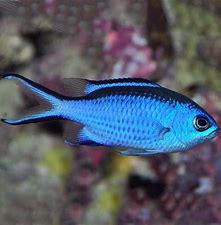
Blue Chromis
The Blue Chromis (Chromis cyanea) is a small, colorful fish that belongs to the family Pomacentridae. Here are some interesting facts about the Blue Chromis:
Appearance: Blue Chromis have a striking appearance with a vibrant blue coloration. Their bodies are slender and elongated, with a slightly forked tail. They have a yellow spot just behind their pectoral fin, and their eyes are outlined in black.
Size: Blue Chromis typically grow to a length of around 3 to 4 inches (7.5 to 10 centimeters). They are considered small reef fish.
Distribution: They are native to the tropical and subtropical waters of the western Atlantic Ocean. Blue Chromis are commonly found in the Caribbean Sea, the Gulf of Mexico, and along the eastern coast of the United States. They also occur in parts of the western Atlantic, including Bermuda and the Bahamas.
Habitat: Blue Chromis are reef-associated fish and inhabit coral reefs, rocky areas, and shallow coastal waters. They are known for their preference for branching coral formations, where they seek shelter and protection.
Social Behavior: Blue Chromis are highly social fish that live in large groups known as schools. These schools can consist of hundreds or even thousands of individuals. The schooling behavior provides protection against predators and allows them to forage more efficiently.
Diet: Blue Chromis are omnivorous and feed on a variety of plankton, small invertebrates, and algae. They are primarily zooplankton feeders, but they also graze on algae present on coral surfaces.
Reproduction: Blue Chromis are oviparous, meaning they reproduce by laying eggs. They engage in external fertilization, where males release sperm to fertilize the eggs released by females. After spawning, the fertilized eggs are left to float in the water column until they hatch into larvae.
Conservation Status: The Blue Chromis is not currently listed as a threatened species. They are generally abundant and have stable populations throughout their range. However, like other reef-associated species, they can be affected by habitat degradation, pollution, and climate change impacts on coral reefs.
Importance in Coral Reef Ecosystems: Blue Chromis play an important ecological role in coral reef ecosystems. They help control populations of zooplankton and small invertebrates, contributing to the balance of the food chain. Additionally, their vibrant blue coloration adds beauty to the underwater landscape.
Aquarium Popularity: Blue Chromis are popular additions to marine aquariums due to their striking appearance and peaceful nature. They can thrive in well-maintained reef aquariums with ample swimming space and hiding spots. However, it is important to ensure compatibility with other tank mates and provide suitable care to meet their specific requirements.